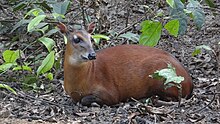Bay duiker
| Bay duiker | |
|---|---|
 |
|
| Individual in Gabon | |
| Scientific classification | |
| Kingdom: | Animalia |
| Phylum: | Chordata |
| Class: | Mammalia |
| Order: | Artiodactyla |
| Family: | Bovidae |
| Genus: | Cephalophus |
| Species: | C. dorsalis |
| Binomial name | |
|
Cephalophus dorsalis Gray, 1849 |
|
| Subspecies | |
|
|
The bay duiker (Cephalophus dorsalis), also known as the black-striped duiker and the black-backed duiker, is a forest-dwelling duiker native to western and southern Africa. It was first described by British zoologist John Edward Gray in 1846. Two subspecies are identified. The bay duiker is reddish brown and has a moderate size. Both sexes reach 44–49 centimetres (17–19 in) at the shoulder. The sexes do not vary considerably in their weights either; the typical weight range for this duiker is 18–23 kilograms (40–51 lb). Both sexes possess a pair of spiky horns, measuring 5–8 centimetres (2.0–3.1 in). A notable feature of this duiker is the well-pronounced solid stripe of black extending from the back of the head to the tail.
The bay duiker is a nocturnal animal. It tends to remain solitary, but pairs can also be observed. The leopard is the main predator of this duiker. The bay duiker mainly prefers fruits, but may also feed on animal matter such as bird eggs. Females may conceive by the age of eighteen months. Breeding occurs throughout the year. Gestation lasts for about 240 days, following which generally a single offspring is born. The lifespan of the bay duiker averages 17 to 18 years.
The bay duiker prefers old-growth or primary forests. It has been historically overhunted across its range for bushmeat. The survival of the bay duiker is also threatened by human settlement and agricultural expansion due to this duiker's preference for old-growth forests, and habitat degradation. The bay duiker is, however, still a common duiker species, and is classified as Near Threatened by the International Union for Conservation of Nature and Natural Resources (IUCN).
...
Wikipedia

